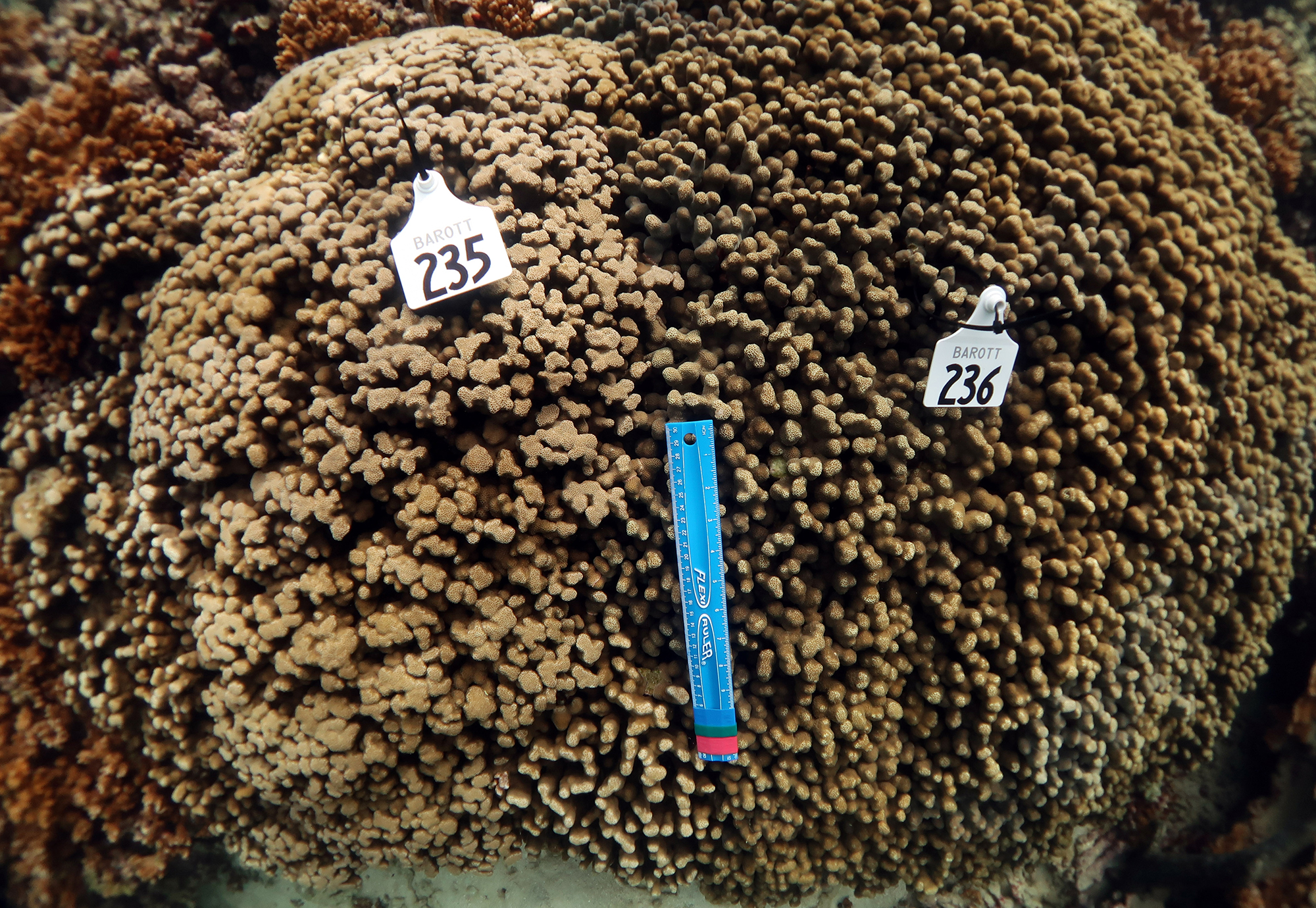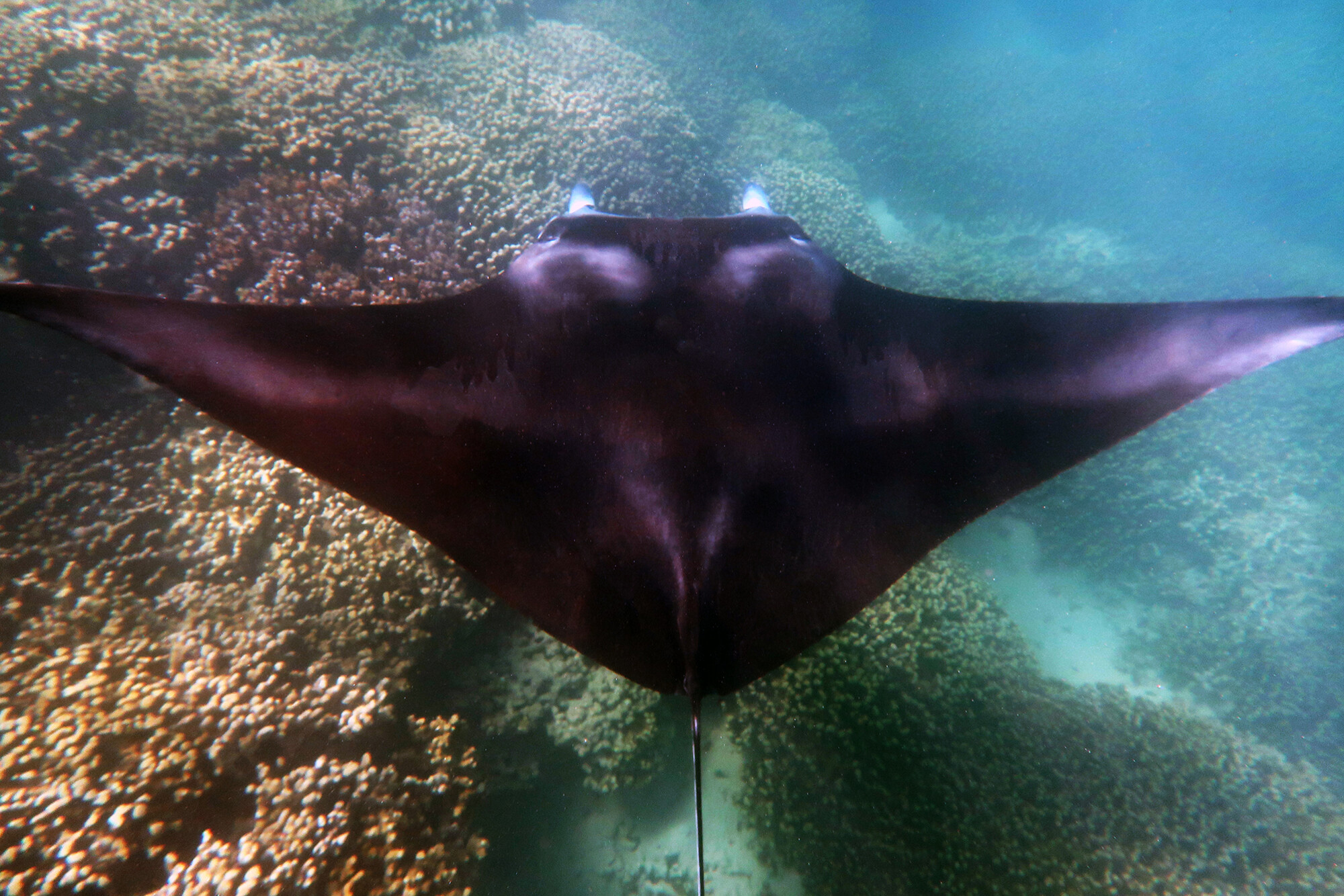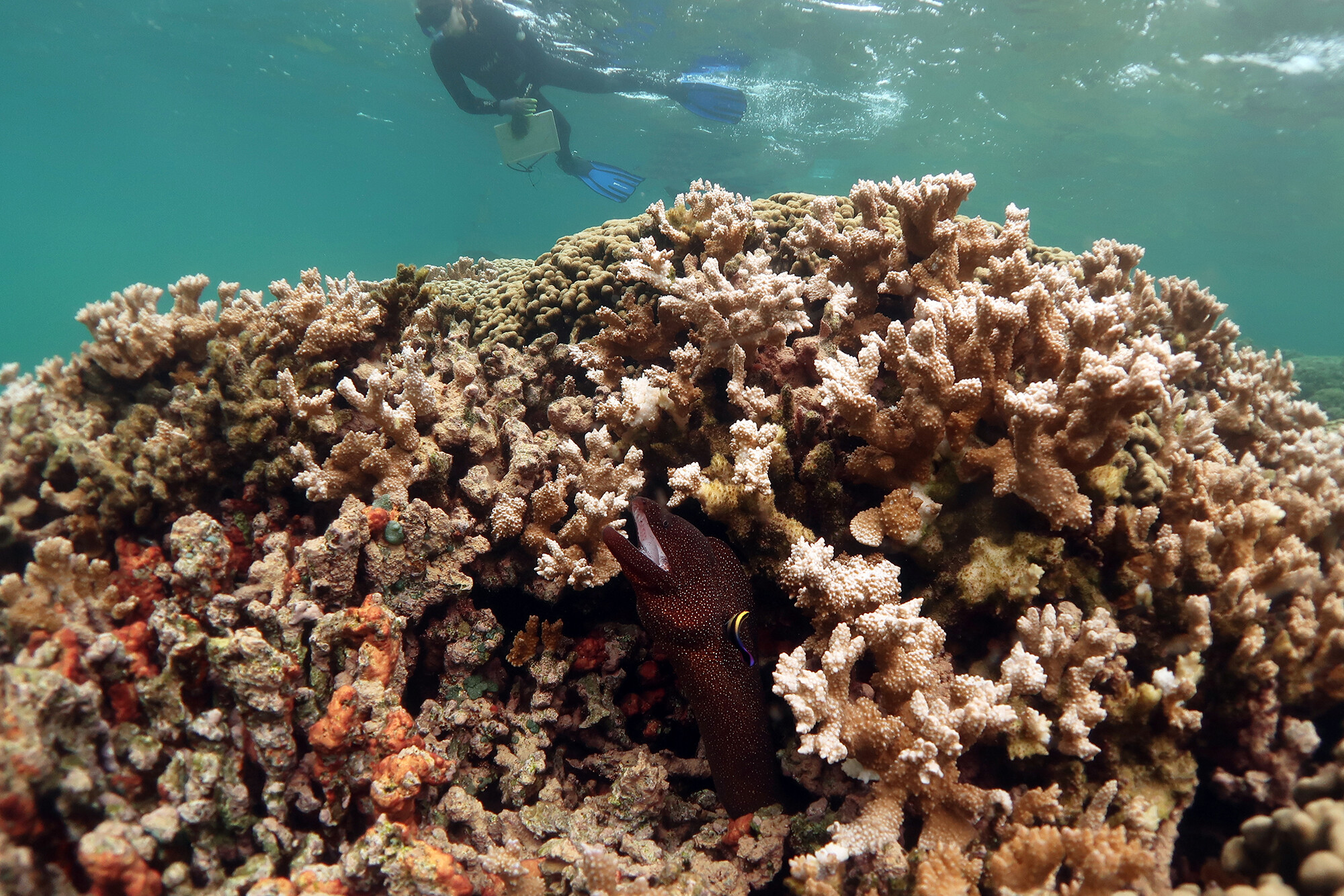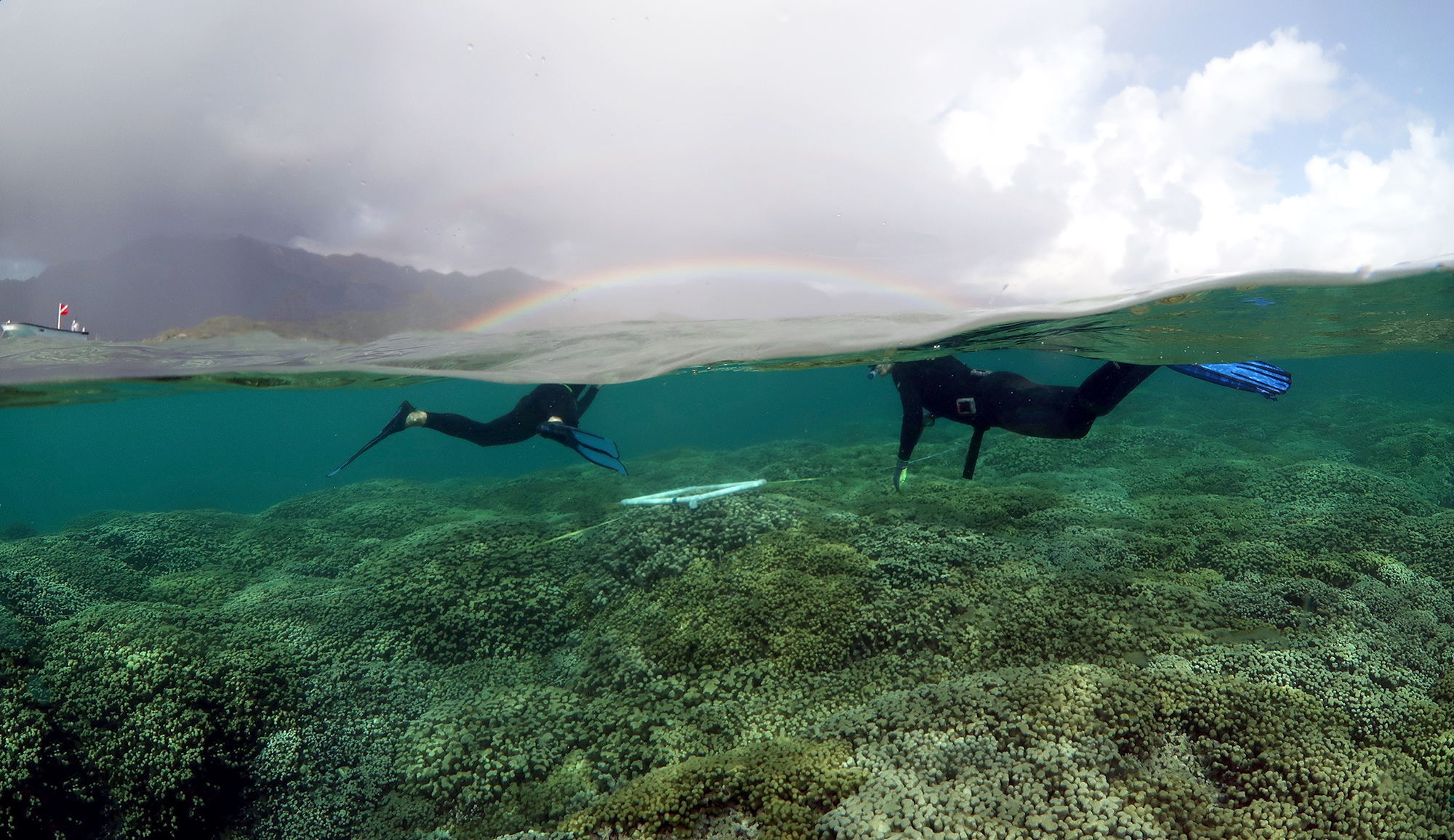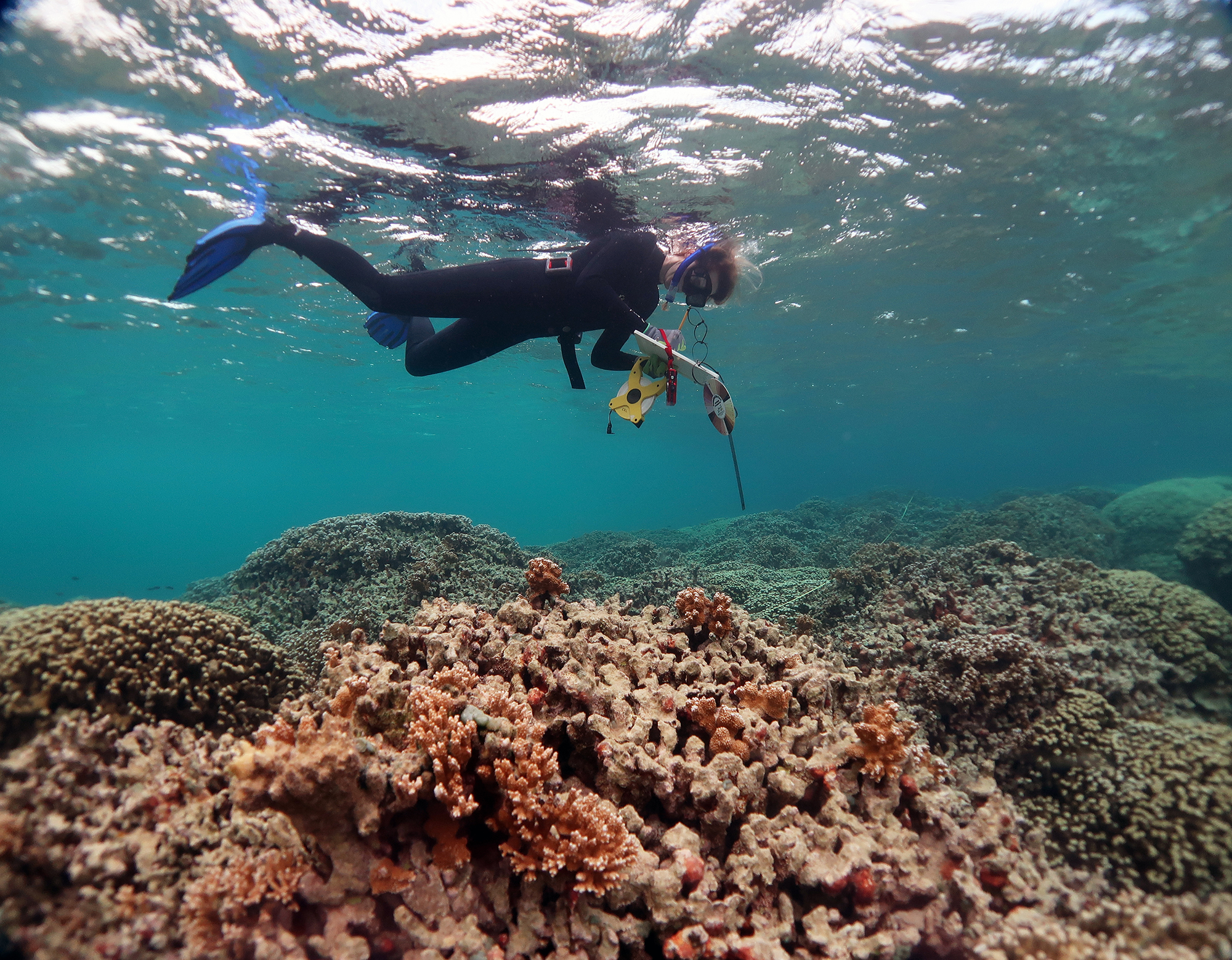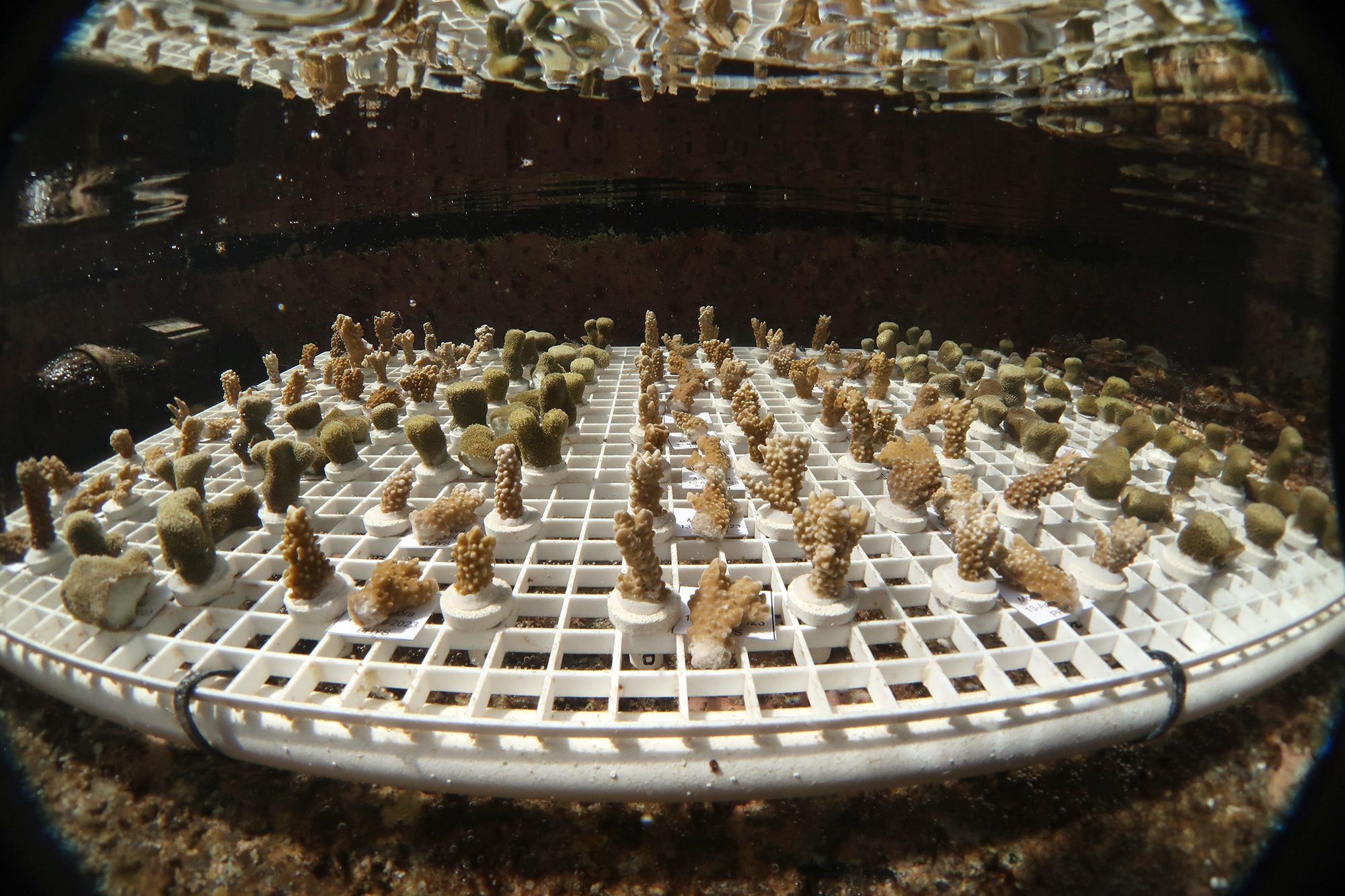
In the balmy waters of Kaneohe Bay in Oahu, Hawaii, beneath the surface where the sun’s rays dance through the undulating waves, a quiet but profound drama unfolds among the local coral reefs. It’s a story of resilience and fragility in the face of climate change, a tale Katie Barott, of the University of Pennsylvania’s School of Arts & Sciences, has been piecing together for nearly 10 years.
In 2015, as Barott recalls, “I was wrapping up my postdoctoral work and there was a major marine heatwave in Hawaii—it was actually the second heatwave event in two years—so, we went out and tagged a whole bunch of coral colonies.”
This marked the beginning of Barott’s study diving into the heart of how corals, those vibrant architects of the underwater world, fare in the face of climate change, the major driver of increasingly warmer waters throughout the Earth’s oceans.
“One of our key discoveries is the role of ‘acclimatization,’” adds Kristen Brown, a postdoctoral researcher in the Barott Lab. “This refers to the ability of some corals to adjust to higher temperatures, thereby reducing their susceptibility to bleaching—a phenomenon wherein corals expel the algae living in their tissues, causing them to turn bright white and increasing the risk of death.”
The researchers studied two dominant coral species: rice coral (Montipora capitata) and finger coral (Porites compressa). Over about a decade, these corals were subjected to three significant marine heatwaves, in 2014, 2015, and in 2019. These provided a unique opportunity to identify bleaching-resistant and bleaching-susceptible individuals of each species, and then observe their responses to repeated heat stress. Their findings, which were recently published in the Proceedings of the National Academy of the Sciences, highlight the resilience of some corals while underscoring the vulnerability of others.
A deeper dive
Corals are a type of marine invertebrate, Barott explains, existing not as solitary organisms but as vast colonies that collectively create complex and varied skeletal structures. These colonies consist of numerous individual coral polyps, which work in unison to form the intricate shapes characteristic of coral reefs. “A crucial aspect of their survival involves a symbiotic relationship with algae, known as zooxanthellae, that reside within the coral’s tissues,” she says. “These algae are essential for the coral’s nourishment, as they perform photosynthesis to produce energy and nutrients that the coral utilizes.”
However, the researchers note, factors such as shifts in water temperature or alterations in the ocean’s pH levels can disrupt this vital partnership. When such disturbances occur, the corals, under stress, expel the algae from their tissues. This expulsion not only deprives the coral of its primary food source but also leads to the loss of the vibrant colors of the coral, a phenomenon known as coral bleaching. Without the algae, the coral’s white skeleton becomes visible through its transparent tissue, signaling a critical state of health for the coral colony.
The team employed a detailed, hands-on approach: They tagged more than 40 individual coral colonies to track their response over time. This method allowed for a precise understanding of how specific corals react to heat stress and the researchers found that bleaching-resistant individuals of both coral species remained pigmented throughout the study period, “suggesting a persistent form of thermal tolerance,” says Barott. “But pigmentation alone was not a definitive indicator of their overall physiological health or resilience.”
In particular, she clarifies, rice coral, despite retaining pigmentation, displayed only partial recovery in symbiont density and tissue, indicating that visual cues alone aren’t sufficient for gauging coral health and resilience. Further, rice coral consistently exhibited bleaching and significant mortality in successive heatwaves, regardless of previous bleaching history. This indicates that bleaching resistance in rice coral was not a reliable predictor of survival or recovery capacity after repeated stress events.
“Conversely, [finger coral] showed signs of beneficial acclimatization,” says Barott. “Initially bleaching-susceptible colonies of this species became less prone to bleaching over time, eventually becoming indistinguishable from their bleaching-resistant counterparts during the third heatwave—suggesting some capacity for resilience to repeated heat stress within this species.”
The study revealed the phenomenon of “environmental memory,” says Brown. “These corals that had undergone these events somehow remember them and were able to alter their physiology and improve their performance in a subsequent event.”
This was a vital insight, suggesting a hitherto unexplored facet of coral resilience. Barott draws parallels to human experiences to explain coral resilience. “It’s sort of like working out, like the more often you exercise the easier it is to go through the same exercise stress,” she says, highlighting the potential for corals to acclimate to repeated stress, a process akin to hardening in plants.
The researchers also note the complex nature of coral resilience and that their findings demonstrated that resistance to bleaching, while beneficial, is not the sole determinant of a coral’s ability to survive and thrive under environmental stress.
In both species, adds Brown, “there were indications of ongoing stress and incomplete recovery in various physiological metrics, even several years after the heatwaves, underscoring the multifaceted nature of coral resilience and the need for more nuanced metrics to assess coral health in the context of climate change.”
The turning tide
Brown, who joined the project more recently in 2020, brought her own experiences from working in Australia on the Great Barrier Reef. “The responses [in Hawaii] are a lot different to the responses that we’re seeing in other reefs, so the way that we think about resilience is kind of changing as these marine heatwaves keep coming,” she says.
Brown’s primary focus was understanding the physiological aspects of coral recovery from 2019 to 2023, a role that heavily involved fieldwork in Hawaii, where she’d take photos and samples of the colonies, which culminated in the massive sample library used in the laboratory analysis. She employed various analytical techniques to assess coral health, such as measuring metabolic rates, symbiont densities, host biomass, and tissue composition.
“This approach was vital in understanding the differences in how various coral species recover after bleaching events,” Brown adds. “This study was one of the first long-term investigations to show these differences at an individual level, which was exciting to be a part of, but on the flipside, it was a bit discouraging to see that that some of our corals fared worse in the end.”
The researchers explain that although finger coral appeared to recover across most physiological metrics within two years and experienced minimal mortality, in contrast, rice coral showed substantial stress across both bleaching phenotypes up to three years following the third heatwave, along with considerable partial mortality. This indicates that even visually robust, bleaching-resistant corals can suffer from the cumulative effects of recurring heatwaves over multiple years, leading to varied recovery paths.
Both scientists remain cautiously optimistic as Barott notes, “This particular reef seems to be doing OK. So, there’s still a lot of living coral I see every time we go back; in the last bleaching event, we lost about 20% of the corals, but it seems like some are recovering and are managing to regrow, so there’s a bit of hope that these reefs are resilient.” However, she maintains that these were mostly the resilient corals, which are now becoming the dominant population, and that there were still large patches on the reef where there were once massive thriving colonies that have now been replaced with bare bones covered in algae.
Moreover, Brown points out, “Three years after that 2019 heatwave, that species of rice coral … still looks like it’s recovering.” This illustrates the prolonged recovery period some corals need after recurring bleaching events.
Charting the course ahead
The researchers explain that this aspect of the research is crucial for identifying which coral species are most likely to survive in warm oceans and could inform conservation strategies in the recent and current El Niño cycle, wherein water in the Pacific Ocean will experience warmer-than-average surface temperatures.
Looking ahead, Barott says they have another five years of funding to keep following these same coral individuals. Their focus will be on growth rates; calcification, the process of building the coral skeleton that generates the reef framework; and changes in how coral growth responds to temperature and heat stress over time. This long-term approach is essential to understand the lasting impacts of heat stress on coral growth and survival.
Additionally, a significant part of future research will be exploring how growth and resilience vary between corals that bleach and those that don’t. This will involve studying the genetic and physiological factors that might confer resilience to certain corals. Understanding these mechanisms is key to predicting how coral reefs will fare in a changing climate.
The findings from this research have significant global implications for coral reef conservation. By identifying resilient coral species and understanding the mechanisms behind their resilience, conservationists can tailor their efforts to protect and restore the most vulnerable coral ecosystems. Furthermore, this research provides valuable insights for policymakers and environmental organizations working toward mitigating the effects of climate change on marine biodiversity.
“Getting to zero carbon emissions is absolutely essential for the survival of coral reefs into the future. So, even though we have signs of resilience, if the only species left is Porites compressa, we’re not going to have the amount of biodiversity and services from these ecosystems that a lot of people rely on, both for their cultural value as well for nutrition. Corals can take years to reach sexual maturity, and some reefs can take thousands of years to fully form, so addressing these losses is urgent and pressing if we want to maintain coral reef ecosystems as we know them.”
Katie Barott is an assistant professor in the University of Pennsylvania School of Arts and Sciences’ Department of Biology.
Kristen Brown is a postdoctoral researcher in the Barott Lab at Penn.
Other authors include Benjamin H. Glass and Elisa Kruse of Penn; Elizabeth A. Lenz, Rayna McClintock, Crawford Drury, and Craig E. Nelson of the University of Hawaii at Manoa; and Hollie M. Putnam od the University of Rhode Island.
This work was supported by the National Science Foundation (awards OCE- 1923743, OCE- 2102989, OCE- 1949033, OCE- 1756623, and OCE- 2103067) and the National Oceanic and Atmospheric Administration (Grant NA22OAR4170108).




